See Page 1 |
2 |
3 |
4 | of the December 2023 homepage archives. Thursday the 21st
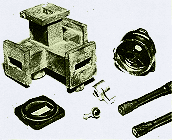 As with the health hazards of smoking, in
1949 when this "Frozen
Mercury Shapes Molds" article appeared in Popular Science magazine,
the severe harm possible from ingestion or absorption of various forms of mercury
were not well-established. The history of determination of physiological effects
of mercury, both elemental and organic, is abundantly available on the Web, so I
won't attempt to replicate it here. Suffice it to say that except under strictly
controlled processes, the use of mercury as an agent for forming casting molds would
never be done nowadays. Wax and Styrofoam are commonly used materials for the "lost-"
technique of molding whereby a solid of easily liquefied material is a "positive"
form encased by a secondary material - often sand or plastic - and then removed
after the "negative" form has set (become solid). A "refractory material," as mentioned
here, is one that remains solid at high temperatures... As with the health hazards of smoking, in
1949 when this "Frozen
Mercury Shapes Molds" article appeared in Popular Science magazine,
the severe harm possible from ingestion or absorption of various forms of mercury
were not well-established. The history of determination of physiological effects
of mercury, both elemental and organic, is abundantly available on the Web, so I
won't attempt to replicate it here. Suffice it to say that except under strictly
controlled processes, the use of mercury as an agent for forming casting molds would
never be done nowadays. Wax and Styrofoam are commonly used materials for the "lost-"
technique of molding whereby a solid of easily liquefied material is a "positive"
form encased by a secondary material - often sand or plastic - and then removed
after the "negative" form has set (become solid). A "refractory material," as mentioned
here, is one that remains solid at high temperatures...
 "On the highway of heat transfer, thermal
energy is moved by way of quantum particles called phonons. But at the nanoscale
of today's most cutting-edge semiconductors, those phonons don't remove enough heat.
That's why Purdue University researchers are focused on opening a new nanoscale
lane on the heat transfer highway by using hybrid quasiparticles called 'polaritons.'
Thomas Beechem loves heat transfer. He talks about it loud and proud, like a preacher
at a big tent revival. “We have several ways of describing energy,” said Beechem,
associate professor of mechanical engineering. “When we talk about light, we describe
it in terms of particles called 'photons.' Heat also carries energy in predictable
ways, and we describe those waves of energy as 'phonons.' But sometimes depending
on the material, photons and phonons will come together and make something new called
a 'polariton.' It carries energy in its own way, distinct from both photons or phonons..." "On the highway of heat transfer, thermal
energy is moved by way of quantum particles called phonons. But at the nanoscale
of today's most cutting-edge semiconductors, those phonons don't remove enough heat.
That's why Purdue University researchers are focused on opening a new nanoscale
lane on the heat transfer highway by using hybrid quasiparticles called 'polaritons.'
Thomas Beechem loves heat transfer. He talks about it loud and proud, like a preacher
at a big tent revival. “We have several ways of describing energy,” said Beechem,
associate professor of mechanical engineering. “When we talk about light, we describe
it in terms of particles called 'photons.' Heat also carries energy in predictable
ways, and we describe those waves of energy as 'phonons.' But sometimes depending
on the material, photons and phonons will come together and make something new called
a 'polariton.' It carries energy in its own way, distinct from both photons or phonons..."
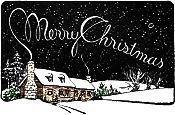 The National Radio Institute (NRI) was one
of the first country-wide organizations to offer formal electronics training both
as classroom and as self-study courses. Magazines were filled with offers to train
men in what was an exciting new career field. The drums of war were beating in the
background in Europe and the South Pacific by December 1940 when this article appeared
in National Radio News, and the U.S. military was gearing up for what was
sure to be an eventuality. Three months earlier, the
Tripartite Pact united Japan, Italy and Germany to formalize the Axis Powers,
and Hitler's forces had invaded Western Europe. The push was on to train a large
number of engineers and technicians to handle communications and control systems
for Army and Navy forces. It is always interesting to read pieces penned at the
time events were unfolding, rather than after having been filtered through the worldview
of subsequent authors... The National Radio Institute (NRI) was one
of the first country-wide organizations to offer formal electronics training both
as classroom and as self-study courses. Magazines were filled with offers to train
men in what was an exciting new career field. The drums of war were beating in the
background in Europe and the South Pacific by December 1940 when this article appeared
in National Radio News, and the U.S. military was gearing up for what was
sure to be an eventuality. Three months earlier, the
Tripartite Pact united Japan, Italy and Germany to formalize the Axis Powers,
and Hitler's forces had invaded Western Europe. The push was on to train a large
number of engineers and technicians to handle communications and control systems
for Army and Navy forces. It is always interesting to read pieces penned at the
time events were unfolding, rather than after having been filtered through the worldview
of subsequent authors...
 San Francisco Circuits, a leading provider
of high-quality printed circuit board (PCB) solutions, has published a new resource
on
PCB assembly drawings covering polarities, Pin 1 marking and anode/cathode
markings. Learn more about understanding the XY file, component locations, and
polarized component orientations on their website. In the realm of printed circuit
board (PCB) manufacturing and assembly, attention to detail is paramount. Every
element, from component placement to orientation, plays a crucial role in ensuring
a successful and efficient assembly process. One vital aspect of this process is
the proper utilization of the assembly drawings... San Francisco Circuits, a leading provider
of high-quality printed circuit board (PCB) solutions, has published a new resource
on
PCB assembly drawings covering polarities, Pin 1 marking and anode/cathode
markings. Learn more about understanding the XY file, component locations, and
polarized component orientations on their website. In the realm of printed circuit
board (PCB) manufacturing and assembly, attention to detail is paramount. Every
element, from component placement to orientation, plays a crucial role in ensuring
a successful and efficient assembly process. One vital aspect of this process is
the proper utilization of the assembly drawings...
 If you grew up in the era of
rooftop
television antennas, then there is a good chance you are familiar with the electromechanical
antenna pointing systems that were often installed as well. Alliance, Channel Master,
Cornell Dubilier, Radio Shack, RCA, Winegard, and others made low cost, light-duty
rotators for television antennas. Ham radio antenna rotators were/are more robust
in order to handle higher weight and wind loads. Many television antennas also cover
the FM radio band (88-108 MHz), allowing them to do double duty. Here are a
few companies (Audiovox and RCA) who still sell antenna rotators that are modern
transistorized units with digital readouts. Some allow you to store channel number
/ antenna direction combinations rather than having to remember the antenna direction
for a particular channel. Customer reviews of the new units reveal dissatisfaction
with the weakness of the rotator unit that mounts on the antenna mast, and the inability
of it to prevent the antenna from being rotated... If you grew up in the era of
rooftop
television antennas, then there is a good chance you are familiar with the electromechanical
antenna pointing systems that were often installed as well. Alliance, Channel Master,
Cornell Dubilier, Radio Shack, RCA, Winegard, and others made low cost, light-duty
rotators for television antennas. Ham radio antenna rotators were/are more robust
in order to handle higher weight and wind loads. Many television antennas also cover
the FM radio band (88-108 MHz), allowing them to do double duty. Here are a
few companies (Audiovox and RCA) who still sell antenna rotators that are modern
transistorized units with digital readouts. Some allow you to store channel number
/ antenna direction combinations rather than having to remember the antenna direction
for a particular channel. Customer reviews of the new units reveal dissatisfaction
with the weakness of the rotator unit that mounts on the antenna mast, and the inability
of it to prevent the antenna from being rotated...
 With more than 1000
custom-built symbols, this has got to be the most comprehensive set of
Visio Symbols
available for RF, analog, and digital system and schematic drawings! Every object
has been built to fit proportionally on the provided A-, B- and C-size drawing page
templates (or can use your own). Symbols are provided for equipment racks and test
equipment, system block diagrams, conceptual drawings, and schematics. Unlike previous
versions, these are NOT Stencils, but instead are all contained on tabbed pages
within a single Visio document. That puts everything in front of you in its full
glory. Just copy and paste what you need on your drawing. The file format is XML
so everything plays nicely with Visio 2013 and later... With more than 1000
custom-built symbols, this has got to be the most comprehensive set of
Visio Symbols
available for RF, analog, and digital system and schematic drawings! Every object
has been built to fit proportionally on the provided A-, B- and C-size drawing page
templates (or can use your own). Symbols are provided for equipment racks and test
equipment, system block diagrams, conceptual drawings, and schematics. Unlike previous
versions, these are NOT Stencils, but instead are all contained on tabbed pages
within a single Visio document. That puts everything in front of you in its full
glory. Just copy and paste what you need on your drawing. The file format is XML
so everything plays nicely with Visio 2013 and later...
 Empower RF Systems is the technological
leader in RF & microwave power amplifier solutions for EW, Radar, Satcom, Threat
Simulation, Communications, and Product Testing. Our air and liquid cooled amplifiers
incorporate the latest semiconductor and power combining technologies and with a
patented architecture we build the most sophisticated and flexible COTS system amplifiers
in the world. Solutions range from tens of watts to hundreds of kilowatts and includes
basic PA modules to scalable rack systems. Empower RF Systems is the technological
leader in RF & microwave power amplifier solutions for EW, Radar, Satcom, Threat
Simulation, Communications, and Product Testing. Our air and liquid cooled amplifiers
incorporate the latest semiconductor and power combining technologies and with a
patented architecture we build the most sophisticated and flexible COTS system amplifiers
in the world. Solutions range from tens of watts to hundreds of kilowatts and includes
basic PA modules to scalable rack systems.
Wednesday the 20th
 The 1,000-meter
radiotelescope at Arecibo, Puerto Rico, the one used by Carl Sagan's team for
broadcasting a "here we are" message toward the globular star cluster M13, in the
constellation of Hercules, back in 1974, experienced a catastrophic mechanical failure
in December of 2020. It saw "first light," a term used by astronomers for the first
time a telescope is used for observation, in November 1963. This article on the
proposed 1,000-meter Arecibo radiotelescope appeared in a 1961 issue of Popular
Mechanics magazine. After many modifications over its lifetime, it operated over
a 300 MHz to 10 GHz range, and although the dish is fixed in position,
the moveable feedhorn facilitates a coverage of -1° to 39° relative to the zenith
position. The transmitters were used for radar measurement of moons and planets.
This document issues by the National Science Foundation in December 2010 announced
the Arecibo Observatory retirement... The 1,000-meter
radiotelescope at Arecibo, Puerto Rico, the one used by Carl Sagan's team for
broadcasting a "here we are" message toward the globular star cluster M13, in the
constellation of Hercules, back in 1974, experienced a catastrophic mechanical failure
in December of 2020. It saw "first light," a term used by astronomers for the first
time a telescope is used for observation, in November 1963. This article on the
proposed 1,000-meter Arecibo radiotelescope appeared in a 1961 issue of Popular
Mechanics magazine. After many modifications over its lifetime, it operated over
a 300 MHz to 10 GHz range, and although the dish is fixed in position,
the moveable feedhorn facilitates a coverage of -1° to 39° relative to the zenith
position. The transmitters were used for radar measurement of moons and planets.
This document issues by the National Science Foundation in December 2010 announced
the Arecibo Observatory retirement...
 In 1936, a high school graduate could expect
to earn about $15 per week, or about 38¢ per hour (40-hour week), in the radio business.
According to the U.S. Bureau of Labor Statistics' Inflation Calculator, that is
the equivalent of around $329 per week in 2023, which is not much to live on these
days. Today, many McDonalds burger flippers are being paid $15 per hour ($600/40-hour
week). That equates to a little over $27 per week in 1936 - nearly twice as much
as an electronics technician who likely has military and/or technical school training.
This 1936 Radio-Craft magazine article discusses the benefits of
formal education in regard to potential earnings in the nascent radio business
in many roles ranging from maintenance technician to broadcaster to management.
The principle generally holds today... In 1936, a high school graduate could expect
to earn about $15 per week, or about 38¢ per hour (40-hour week), in the radio business.
According to the U.S. Bureau of Labor Statistics' Inflation Calculator, that is
the equivalent of around $329 per week in 2023, which is not much to live on these
days. Today, many McDonalds burger flippers are being paid $15 per hour ($600/40-hour
week). That equates to a little over $27 per week in 1936 - nearly twice as much
as an electronics technician who likely has military and/or technical school training.
This 1936 Radio-Craft magazine article discusses the benefits of
formal education in regard to potential earnings in the nascent radio business
in many roles ranging from maintenance technician to broadcaster to management.
The principle generally holds today...
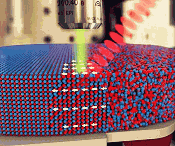 "In the world of materials science, discoveries
that challenge established norms often lead to groundbreaking innovations. Such
is the case with a fascinating development involving
laser-induced magnetization, a technique that was initially uncovered in 2018
by researchers at the Helmholtz-Zentrum Dresden-Rossendorf (HZDR). In a recent collaboration
with the Laserinstitut Hochschule Mittweida (LHM), this method has been further
explored, revealing its potential to revolutionize various industries. This article
delves into the details of this discovery and its implications. The Unexpected Discovery
In 2018, scientists at HZDR made a startling observation. They found that by subjecting
a thin layer of an iron-aluminum alloy to ultrashort laser pulses, the material,
which was previously non-magnetic, transformed into a magnet. This intriguing phenomenon
occurred because the laser pulses triggered a rearrangement of the atoms within
the crystal lattice, causing the iron atoms to move closer together. Subsequently,
these atoms formed a magnet. Remarkably, the researchers could reverse this magnetization
by employing a series of weaker laser pulses..." "In the world of materials science, discoveries
that challenge established norms often lead to groundbreaking innovations. Such
is the case with a fascinating development involving
laser-induced magnetization, a technique that was initially uncovered in 2018
by researchers at the Helmholtz-Zentrum Dresden-Rossendorf (HZDR). In a recent collaboration
with the Laserinstitut Hochschule Mittweida (LHM), this method has been further
explored, revealing its potential to revolutionize various industries. This article
delves into the details of this discovery and its implications. The Unexpected Discovery
In 2018, scientists at HZDR made a startling observation. They found that by subjecting
a thin layer of an iron-aluminum alloy to ultrashort laser pulses, the material,
which was previously non-magnetic, transformed into a magnet. This intriguing phenomenon
occurred because the laser pulses triggered a rearrangement of the atoms within
the crystal lattice, causing the iron atoms to move closer together. Subsequently,
these atoms formed a magnet. Remarkably, the researchers could reverse this magnetization
by employing a series of weaker laser pulses..."
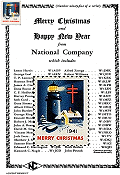 Take a look at the list of
National Company's employee list wishing their customers a Merry Christmas and
a Happy New Year. Every one of them is a licensed Ham radio operator. It appeared
in the January 1942 issue of ARRL's QST magazine, but was for the 1941
Christmas. National Company was a major producer of amateur radio gear in the day.
Little did they suspect when the magazine went to print that by the time readers
received it, America would be newly engaged in World War II after the Japanese
attack on Pearl Harbor on December 7, 1941. Many of the names would be different
in1943 due to employees going off to fight the war in the European, Pacific, and
North African Theaters of Operation... Take a look at the list of
National Company's employee list wishing their customers a Merry Christmas and
a Happy New Year. Every one of them is a licensed Ham radio operator. It appeared
in the January 1942 issue of ARRL's QST magazine, but was for the 1941
Christmas. National Company was a major producer of amateur radio gear in the day.
Little did they suspect when the magazine went to print that by the time readers
received it, America would be newly engaged in World War II after the Japanese
attack on Pearl Harbor on December 7, 1941. Many of the names would be different
in1943 due to employees going off to fight the war in the European, Pacific, and
North African Theaters of Operation...
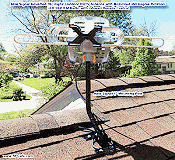 Since I do not have time to watch television
on a regular basis, paying for a cable or satellite subscription cannot be justified.
My plan was to install a traditional
FM/VHF/UHF television antenna on the roof along with a rotator. Some pretty
nice models are still available from Channel Master and a few others. TV broadcast
stations in the Erie area are all within 10 miles or so, so signal strength would
not be an issue. I listen to both AM and FM radio most of the day, so being able
to get an FM signal boost from a steerable antenna would be a nice bonus since occasionally
reorienting the FM dipole was needed to get a clear signal. The entire outfit would
cost less than a year's subscription price for cable or satellite television... Since I do not have time to watch television
on a regular basis, paying for a cable or satellite subscription cannot be justified.
My plan was to install a traditional
FM/VHF/UHF television antenna on the roof along with a rotator. Some pretty
nice models are still available from Channel Master and a few others. TV broadcast
stations in the Erie area are all within 10 miles or so, so signal strength would
not be an issue. I listen to both AM and FM radio most of the day, so being able
to get an FM signal boost from a steerable antenna would be a nice bonus since occasionally
reorienting the FM dipole was needed to get a clear signal. The entire outfit would
cost less than a year's subscription price for cable or satellite television...
 It was a lot of work, but I finally finished
a version of the "RF &
Electronics Schematic & Block Diagram Symbols"" that works well with Microsoft
Office™ programs Word™, Excel™, and Power Point™. This is an equivalent of the extensive
set of amplifier, mixer, filter, switch, connector, waveguide, digital, analog,
antenna, and other commonly used symbols for system block diagrams and schematics
created for Visio™. Each of the 1,000 or so symbols was exported individually from
Visio in the EMF file format, then imported into Word on a Drawing Canvas. The EMF
format allows an image to be scaled up or down without becoming pixelated, so all
the shapes can be resized in a document and still look good. The imported symbols
can also be UnGrouped into their original constituent parts for editing. Check them
out! It was a lot of work, but I finally finished
a version of the "RF &
Electronics Schematic & Block Diagram Symbols"" that works well with Microsoft
Office™ programs Word™, Excel™, and Power Point™. This is an equivalent of the extensive
set of amplifier, mixer, filter, switch, connector, waveguide, digital, analog,
antenna, and other commonly used symbols for system block diagrams and schematics
created for Visio™. Each of the 1,000 or so symbols was exported individually from
Visio in the EMF file format, then imported into Word on a Drawing Canvas. The EMF
format allows an image to be scaled up or down without becoming pixelated, so all
the shapes can be resized in a document and still look good. The imported symbols
can also be UnGrouped into their original constituent parts for editing. Check them
out!
Tuesday the 19th
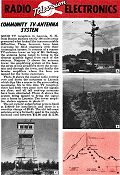 Most of the television programming I have
watched in my 65+ years has been received over the air from a broadcast tower to
a rooftop antenna (or occasionally a set of rabbit ears). Rarely have I had to resort
to cable. An antenna, rotator, and lead-in cable in today's dollars represents an
investment of around $100-$150. Most TV these days is delivered via an Internet
connection. I don't even know whether old-fashioned set-top cable boxes are used
exclusively for television. In 1953, when this "Community
TV-Antenna System" article appeared in a 1953 issue of Popular Mechanics
magazine, TV broadcast stations had been fairly well established across the country,
but were not as dense as today. Some locations which did not have a station within
50 miles or so had difficulty getting acceptable reception - especially if surrounded
by hills or mountains. As color broadcasts became more prevalent, demand for high
quality signals increased, and people were willing to pay dearly for it. Residents
of Laconia, New Hampshire, shelled out $169 ($1,954 in 2023 money) for installation
and then a monthly subscription fee of $3.95 ($45 in 2023). According to the U.S.
Census... Most of the television programming I have
watched in my 65+ years has been received over the air from a broadcast tower to
a rooftop antenna (or occasionally a set of rabbit ears). Rarely have I had to resort
to cable. An antenna, rotator, and lead-in cable in today's dollars represents an
investment of around $100-$150. Most TV these days is delivered via an Internet
connection. I don't even know whether old-fashioned set-top cable boxes are used
exclusively for television. In 1953, when this "Community
TV-Antenna System" article appeared in a 1953 issue of Popular Mechanics
magazine, TV broadcast stations had been fairly well established across the country,
but were not as dense as today. Some locations which did not have a station within
50 miles or so had difficulty getting acceptable reception - especially if surrounded
by hills or mountains. As color broadcasts became more prevalent, demand for high
quality signals increased, and people were willing to pay dearly for it. Residents
of Laconia, New Hampshire, shelled out $169 ($1,954 in 2023 money) for installation
and then a monthly subscription fee of $3.95 ($45 in 2023). According to the U.S.
Census...
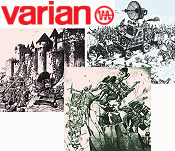 Thanks to J.C. for providing three more
of the
Varian
Associates radar comics - that's a total of twenty thus far. The original text
on these is in German poem form, so the Google translations have lost some context.
Fortunately J.C., a German who lives in Germany, provided a translation in modern
lingo. A few years ago, another frequent RF Cafe visitor who goes by the moniker
"Unknown Engineer" sent me a hyperlink to a PDF file on Amazon's CloudFront content
delivery network (CDN - basically a file server) that contained no fewer than 17
amazing radar and vacuum tube related line drawings published by Varian Associates'
TWT Division, Palo Alto Tube Division, Solid State Division, Eastern Tube Division,
Western Tube Division, Solid State West Division. These highly detailed and busy
drawings were done around 1975 by British illustrator/artist C.E.B. Bernard; a search
for his works did not reveal much. The events shown are fictitious, as are the accompanying
hand-printed stories. Some of the puns are pretty clever, but are somewhat dated
for today's readers... Thanks to J.C. for providing three more
of the
Varian
Associates radar comics - that's a total of twenty thus far. The original text
on these is in German poem form, so the Google translations have lost some context.
Fortunately J.C., a German who lives in Germany, provided a translation in modern
lingo. A few years ago, another frequent RF Cafe visitor who goes by the moniker
"Unknown Engineer" sent me a hyperlink to a PDF file on Amazon's CloudFront content
delivery network (CDN - basically a file server) that contained no fewer than 17
amazing radar and vacuum tube related line drawings published by Varian Associates'
TWT Division, Palo Alto Tube Division, Solid State Division, Eastern Tube Division,
Western Tube Division, Solid State West Division. These highly detailed and busy
drawings were done around 1975 by British illustrator/artist C.E.B. Bernard; a search
for his works did not reveal much. The events shown are fictitious, as are the accompanying
hand-printed stories. Some of the puns are pretty clever, but are somewhat dated
for today's readers...
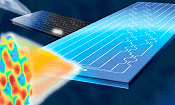 "New advanced
photonic chips have been developed that optimize light transmission for optical
wireless systems. These chips, essential for future 5G and 6G networks, represent
a shift towards energy-efficient analog technologies and have wide-ranging applications
in high-speed data processing and communication. A new breakthrough in optical wireless
technology features photonic chips that efficiently shape light for improved data
transmission, pivotal for the advancement of future wireless networks and high-speed
data processing. Optical wireless may no longer have any obstacles. A study by Politecnico
di Milano, conducted together with Scuola Superiore Sant'Anna in Pisa, the University
of Glasgow, and Stanford University, and published in the prestigious journal Nature
Photonics, has made it possible to create photonic chips that mathematically calculate
the optimal shape of light to best pass through any environment, even one that is
unknown or changing over time. The problem is well known: light is sensitive to
any form of obstacle, even very small ones..." "New advanced
photonic chips have been developed that optimize light transmission for optical
wireless systems. These chips, essential for future 5G and 6G networks, represent
a shift towards energy-efficient analog technologies and have wide-ranging applications
in high-speed data processing and communication. A new breakthrough in optical wireless
technology features photonic chips that efficiently shape light for improved data
transmission, pivotal for the advancement of future wireless networks and high-speed
data processing. Optical wireless may no longer have any obstacles. A study by Politecnico
di Milano, conducted together with Scuola Superiore Sant'Anna in Pisa, the University
of Glasgow, and Stanford University, and published in the prestigious journal Nature
Photonics, has made it possible to create photonic chips that mathematically calculate
the optimal shape of light to best pass through any environment, even one that is
unknown or changing over time. The problem is well known: light is sensitive to
any form of obstacle, even very small ones..."
 "Tokyo is now a next-door neighbor - thanks
to the magic of short-waves." That statement was made in a 1935 edition of Short
Wave Craft magazine after the American Telephone and Telegraph (AT&T) company
completed its wireless
phone (voice) link between the U.S. and Japan; which is the first "T" in AT&T.
Most people today would probably have a hard time guessing that the second "T" in
AT&T stands for "telegraph." Its surprising that the name has not been changed
to reflect the outdated-ness. Western Union sent its final telegraph in 2006. Another
news headline a couple years ago reported on India sending its final official telegraph
message. Note that this predated the attack on Pearl Harbor in December of 1941. "Tokyo is now a next-door neighbor - thanks
to the magic of short-waves." That statement was made in a 1935 edition of Short
Wave Craft magazine after the American Telephone and Telegraph (AT&T) company
completed its wireless
phone (voice) link between the U.S. and Japan; which is the first "T" in AT&T.
Most people today would probably have a hard time guessing that the second "T" in
AT&T stands for "telegraph." Its surprising that the name has not been changed
to reflect the outdated-ness. Western Union sent its final telegraph in 2006. Another
news headline a couple years ago reported on India sending its final official telegraph
message. Note that this predated the attack on Pearl Harbor in December of 1941.
 Banner Ads are rotated in all locations
on the page! RF Cafe typically receives 8,000-15,000 visits each
weekday. RF Cafe
is a favorite of engineers, technicians, hobbyists, and students all over the world.
With more than 17,000 pages in the Google search index, RF Cafe returns in
favorable positions on many types of key searches, both for text and images.
Your Banner Ads are displayed on average 280,000 times per year! New content
is added on a daily basis, which keeps the major search engines interested enough
to spider it multiple times each day. Items added on the homepage often can be found
in a Google search within a few hours of being posted. If you need your company news to be seen, RF Cafe is the
place to be... Banner Ads are rotated in all locations
on the page! RF Cafe typically receives 8,000-15,000 visits each
weekday. RF Cafe
is a favorite of engineers, technicians, hobbyists, and students all over the world.
With more than 17,000 pages in the Google search index, RF Cafe returns in
favorable positions on many types of key searches, both for text and images.
Your Banner Ads are displayed on average 280,000 times per year! New content
is added on a daily basis, which keeps the major search engines interested enough
to spider it multiple times each day. Items added on the homepage often can be found
in a Google search within a few hours of being posted. If you need your company news to be seen, RF Cafe is the
place to be...
Monday the 18th
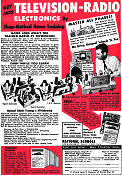 This is just one of many full-page advertisements
in the December 1950 issue of Mechanix Illustrated magazine for
electronics service schools. There was also Coyne Electrical & Television-Radio
School, De Forests' Training (yes, THAT de Forest), deVry Institute, and
a couple others. Electronics for home and industry was big business following World
War II, both from the enormous amount of new knowledge gained in components,
circuits, and manufacturing, and from the near total lack of consumer products being
turned out by manufacturers while wartime rules mandated that all available resources
be dedicated to the effort. In fact, immediately after the end of the war, aircraft,
electronics, automobile, and many other industries went into a major downturn as
government contracts were pulled overnight, leaving companies high and dry with
no orders and factory floors which had been reconfigured to meet government demands.
Of course those companies and employees enjoyed handsome profits and all the work
they could handle for half a decade, so they couldn't complain too much... This is just one of many full-page advertisements
in the December 1950 issue of Mechanix Illustrated magazine for
electronics service schools. There was also Coyne Electrical & Television-Radio
School, De Forests' Training (yes, THAT de Forest), deVry Institute, and
a couple others. Electronics for home and industry was big business following World
War II, both from the enormous amount of new knowledge gained in components,
circuits, and manufacturing, and from the near total lack of consumer products being
turned out by manufacturers while wartime rules mandated that all available resources
be dedicated to the effort. In fact, immediately after the end of the war, aircraft,
electronics, automobile, and many other industries went into a major downturn as
government contracts were pulled overnight, leaving companies high and dry with
no orders and factory floors which had been reconfigured to meet government demands.
Of course those companies and employees enjoyed handsome profits and all the work
they could handle for half a decade, so they couldn't complain too much...
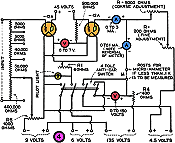 You are taught early in your electronics
career to be mindful of the tendency for
measurement equipment to affect the circuit it is measuring, and therefore the
indicated results. In the case of high frequency circuits, even minute amounts of
capacitance and/or inductance can render results utterly unusable, but even in circuits
operating down to D.C. the simple internal resistance of a meter can profoundly
affect measurement accuracy. High impedance circuits are particularly vulnerable
to such "loading" effects by test equipment. For example, consider a circuit being
measured (device under test, aka DUT) that has an impedance of 10 kΩ and the
internal resistance of the VOM is 100 kΩ (see diagram to left). If the open
circuit "true" voltage level is 11 V, then voltage division effected by the
100 kΩ meter in series with the DUT's 10 kΩ internal resistance would
produce a VOM reading of 10 V... You are taught early in your electronics
career to be mindful of the tendency for
measurement equipment to affect the circuit it is measuring, and therefore the
indicated results. In the case of high frequency circuits, even minute amounts of
capacitance and/or inductance can render results utterly unusable, but even in circuits
operating down to D.C. the simple internal resistance of a meter can profoundly
affect measurement accuracy. High impedance circuits are particularly vulnerable
to such "loading" effects by test equipment. For example, consider a circuit being
measured (device under test, aka DUT) that has an impedance of 10 kΩ and the
internal resistance of the VOM is 100 kΩ (see diagram to left). If the open
circuit "true" voltage level is 11 V, then voltage division effected by the
100 kΩ meter in series with the DUT's 10 kΩ internal resistance would
produce a VOM reading of 10 V...
 I was too young to remember where I was
when President Kennedy was shot in 1963, but I do remember hearing of Rev. King's
shooting (and massive riots) in 1968, President Reagan being shot in 1981, and the
Islamist attack in America on September 11, 2001. I also remember seeing
Halley's Comet during its
last appearance in 1986. Melanie and I were in a condo in Arnold, Maryland, preparing
to move to Burlington, Vermont. The perihelion (orbit's closest point to sun) then
was February 9th. The next perihelion is July 28, 2061. On December 8th of this
year, Halley's Comet reached aphelion (farthest point from sun) and is now on its
way back. Melanie will be 100 years old, and I will probably be taking a dirt nap
by then (born 1958). Mark Twain
(Samuel Clemmons) was born in
1835 under Halley's
Comet, and predicted he would live until the next appearance in
1910. He was right. I was too young to remember where I was
when President Kennedy was shot in 1963, but I do remember hearing of Rev. King's
shooting (and massive riots) in 1968, President Reagan being shot in 1981, and the
Islamist attack in America on September 11, 2001. I also remember seeing
Halley's Comet during its
last appearance in 1986. Melanie and I were in a condo in Arnold, Maryland, preparing
to move to Burlington, Vermont. The perihelion (orbit's closest point to sun) then
was February 9th. The next perihelion is July 28, 2061. On December 8th of this
year, Halley's Comet reached aphelion (farthest point from sun) and is now on its
way back. Melanie will be 100 years old, and I will probably be taking a dirt nap
by then (born 1958). Mark Twain
(Samuel Clemmons) was born in
1835 under Halley's
Comet, and predicted he would live until the next appearance in
1910. He was right.
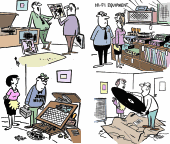 Comics in modern magazines are a rather
rare phenomenon for some reason, but they were fairly regular features up until
a couple decades ago. Maybe publishers are too afraid of offending some squish.
This set of comics from the July 1963 edition of Popular Electronics magazine
deals with high fidelity (Hi-Fi) stereo equipment, which was considered somewhat
exotic and high-end for many people's budgets in the day. Inexplicably (not), that
is about the time that increases in hearing losses among younger people were first
being noticed in audiograms. I listened to my share of loud music beginning in the
late 1960s, and operated many model airplane engines and lawnmower type engines
my whole life, and still, at 65 years old, can hear a pin drop in the next room.
I am blind as a bat, however (~20/240, corrected to nearly 20/20)... Comics in modern magazines are a rather
rare phenomenon for some reason, but they were fairly regular features up until
a couple decades ago. Maybe publishers are too afraid of offending some squish.
This set of comics from the July 1963 edition of Popular Electronics magazine
deals with high fidelity (Hi-Fi) stereo equipment, which was considered somewhat
exotic and high-end for many people's budgets in the day. Inexplicably (not), that
is about the time that increases in hearing losses among younger people were first
being noticed in audiograms. I listened to my share of loud music beginning in the
late 1960s, and operated many model airplane engines and lawnmower type engines
my whole life, and still, at 65 years old, can hear a pin drop in the next room.
I am blind as a bat, however (~20/240, corrected to nearly 20/20)...
 Werbel Microwave is a manufacturer of RF
directional and bidirectional couplers (6 dB to 30 dB) and RF power dividers
/ combiners (2- to 16-way) with select models operating up to 26.5 GHz and
100 W of CW power (3 kW peak). All are RoHS and REACH compliant and are
designed and manufactured in our Whippany, NJ, location. Custom products and private
label service available. Please take a couple minutes to visit their website and
see how Werbel Microwave can help you today. Werbel Microwave is a manufacturer of RF
directional and bidirectional couplers (6 dB to 30 dB) and RF power dividers
/ combiners (2- to 16-way) with select models operating up to 26.5 GHz and
100 W of CW power (3 kW peak). All are RoHS and REACH compliant and are
designed and manufactured in our Whippany, NJ, location. Custom products and private
label service available. Please take a couple minutes to visit their website and
see how Werbel Microwave can help you today.
Sunday the 17th
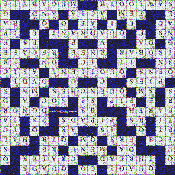 This custom RF Cafe
electronics-themed crossword puzzle for December 17th contains words and clues
which pertain exclusively to the subjects of electronics, science, physics, mechanics,
engineering, power distribution, astronomy, chemistry, etc. Given that today is
the 17th day of the month, many words in this crossword start or end (or contain)
the 17th letter, "Q." Related clues are marked with an asterisk (*). You might expect
a few Ham radio-related words and abbreviations in this one. If you do see names
of people or places, they are intimately related to the aforementioned areas of
study. As always, you will find no references to numbnut movie stars or fashion
designers. Need more crossword RF Cafe puzzles? A list at the bottom of the page
links to hundreds of them dating back to the year 2000. Enjoy... This custom RF Cafe
electronics-themed crossword puzzle for December 17th contains words and clues
which pertain exclusively to the subjects of electronics, science, physics, mechanics,
engineering, power distribution, astronomy, chemistry, etc. Given that today is
the 17th day of the month, many words in this crossword start or end (or contain)
the 17th letter, "Q." Related clues are marked with an asterisk (*). You might expect
a few Ham radio-related words and abbreviations in this one. If you do see names
of people or places, they are intimately related to the aforementioned areas of
study. As always, you will find no references to numbnut movie stars or fashion
designers. Need more crossword RF Cafe puzzles? A list at the bottom of the page
links to hundreds of them dating back to the year 2000. Enjoy...
Friday the 16th
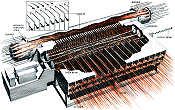 Those of us who grew up in the 1960s and
1970s were inundated with books, movies, television shows, magazines, comic books,
toys and other forms of promotion for the promises of lasers - both fictional and
real - remember seeing articles like this one in a 1972 issue of Popular Science.
Heck, there's a good chance I read this when it originally came out. At the time,
laser power levels were measured in the hundreds or maybe a few thousands of watts.
It wasn't long before that a watt produced from the lasing in rubies was considered
an accomplishment. By this time chemical lasers were (and are today) the workhorses
of
laser weapons. Much of the state of the art in lasers has always been a well-kept
secret by military and government research and defense contracting agencies. Interestingly,
author Albright claims much of what he reports was gleaned by assimilating bits
of information from diverse sources. It's a good example of the "loose lips sink
ships" saying from World War II, whereby the enemy can figure out what you
are doing even without clandestine sources (aka spies) embedded in the works... Those of us who grew up in the 1960s and
1970s were inundated with books, movies, television shows, magazines, comic books,
toys and other forms of promotion for the promises of lasers - both fictional and
real - remember seeing articles like this one in a 1972 issue of Popular Science.
Heck, there's a good chance I read this when it originally came out. At the time,
laser power levels were measured in the hundreds or maybe a few thousands of watts.
It wasn't long before that a watt produced from the lasing in rubies was considered
an accomplishment. By this time chemical lasers were (and are today) the workhorses
of
laser weapons. Much of the state of the art in lasers has always been a well-kept
secret by military and government research and defense contracting agencies. Interestingly,
author Albright claims much of what he reports was gleaned by assimilating bits
of information from diverse sources. It's a good example of the "loose lips sink
ships" saying from World War II, whereby the enemy can figure out what you
are doing even without clandestine sources (aka spies) embedded in the works...
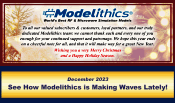 Modelithics sends out this holiday message:
"To all our valued subscribers & customers, loyal partners, and our truly dedicated
Modelithics team: we cannot thank each and every one of you enough for your continued
support and patronage. We hope this year ends on a cheerful note for all, and the
it will make way for a great New Year. Wishing you a very Merry Christmas and a
Happy Holiday Season." Modelithics sends out this holiday message:
"To all our valued subscribers & customers, loyal partners, and our truly dedicated
Modelithics team: we cannot thank each and every one of you enough for your continued
support and patronage. We hope this year ends on a cheerful note for all, and the
it will make way for a great New Year. Wishing you a very Merry Christmas and a
Happy Holiday Season."
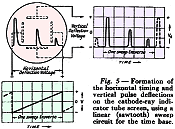 "The prospective peacetime
applications of radar are beyond prediction. Among the more obvious are those
relating to navigational aids and collision prevention. In some of these uses it
will be a case of radar replacing radio." That was 78 years ago when real-world
radar was still in its infancy that futurists were prognosticating on potential
uses for radar beyond its use for the war effort. Just a month after this April
issue of QST magazine was published, the war in Europe ended (V-E Day,
May 8, 1945), and four months after that the war in Japan ended (V-J Day, August
14, 1945). Editor DeSoto would be utterly amazed at just how widespread radar is
today. It not only surveys the airways for commercial, military, and civilian craft,
but also for marine and land traffic, orbiting spacecraft, and planetary science.
Law enforcement uses it to add to the department... "The prospective peacetime
applications of radar are beyond prediction. Among the more obvious are those
relating to navigational aids and collision prevention. In some of these uses it
will be a case of radar replacing radio." That was 78 years ago when real-world
radar was still in its infancy that futurists were prognosticating on potential
uses for radar beyond its use for the war effort. Just a month after this April
issue of QST magazine was published, the war in Europe ended (V-E Day,
May 8, 1945), and four months after that the war in Japan ended (V-J Day, August
14, 1945). Editor DeSoto would be utterly amazed at just how widespread radar is
today. It not only surveys the airways for commercial, military, and civilian craft,
but also for marine and land traffic, orbiting spacecraft, and planetary science.
Law enforcement uses it to add to the department...
 The newest release of RF Cafe's spreadsheet
(Excel) based engineering and science calculator is now available -
Espresso Engineering Workbook™. Among other additions, it now has a Butterworth
Bandpass Calculator, and a Highpass Filter Calculator that does not just gain, but
also phase and group delay! Since 2002,
the original Calculator Workbook has been available as a free download.
Continuing the tradition, RF Cafe Espresso Engineering Workbook™ is
also provided at no cost,
compliments of my generous sponsors. The original calculators are included, but
with a vastly expanded and improved user interface. Error-trapped user input cells
help prevent entry of invalid values. An extensive use of Visual Basic for Applications
(VBA) functions now do most of the heavy lifting with calculations, and facilitates
a wide user-selectable choice of units for voltage, frequency, speed, temperature,
power, wavelength, weight, etc. In fact, a full page of units conversion calculators
is included. A particularly handy feature is the ability to specify the the number
of significant digits to display. Drop-down menus are provided for convenience... The newest release of RF Cafe's spreadsheet
(Excel) based engineering and science calculator is now available -
Espresso Engineering Workbook™. Among other additions, it now has a Butterworth
Bandpass Calculator, and a Highpass Filter Calculator that does not just gain, but
also phase and group delay! Since 2002,
the original Calculator Workbook has been available as a free download.
Continuing the tradition, RF Cafe Espresso Engineering Workbook™ is
also provided at no cost,
compliments of my generous sponsors. The original calculators are included, but
with a vastly expanded and improved user interface. Error-trapped user input cells
help prevent entry of invalid values. An extensive use of Visual Basic for Applications
(VBA) functions now do most of the heavy lifting with calculations, and facilitates
a wide user-selectable choice of units for voltage, frequency, speed, temperature,
power, wavelength, weight, etc. In fact, a full page of units conversion calculators
is included. A particularly handy feature is the ability to specify the the number
of significant digits to display. Drop-down menus are provided for convenience...
 Homodyne reception, although we don't often
refer to it today using that term, involves mixing the modulated signal with a local
oscillator that is tuned to the same frequency so that the demodulated signal is
at baseband. In other words, the result of a homodyne nonlinear mixing process is
a sum frequency of 2x the signal input and the difference frequency is DC (at the
low end of the modulation). That is a simplistic explanation, and this 1942
Radio-Craft magazine article goes into a little more detail about methods,
advantages, and disadvantages. Why not just make things simple and make every receiver
a homodyne circuit? The answer is that with homodyne operation every theoretically
possible mixer spurious product will fall inband without any means of filtering
them out. Sometimes it doesn't matter, but especially in today's crowded radio spectrum
it just is not workable because the interference level would be too intolerable... Homodyne reception, although we don't often
refer to it today using that term, involves mixing the modulated signal with a local
oscillator that is tuned to the same frequency so that the demodulated signal is
at baseband. In other words, the result of a homodyne nonlinear mixing process is
a sum frequency of 2x the signal input and the difference frequency is DC (at the
low end of the modulation). That is a simplistic explanation, and this 1942
Radio-Craft magazine article goes into a little more detail about methods,
advantages, and disadvantages. Why not just make things simple and make every receiver
a homodyne circuit? The answer is that with homodyne operation every theoretically
possible mixer spurious product will fall inband without any means of filtering
them out. Sometimes it doesn't matter, but especially in today's crowded radio spectrum
it just is not workable because the interference level would be too intolerable...
 One aspect of advertising on the RF Cafe
website I have not covered is using
Google AdSense.
The reason is that I never took the time to explore how - or even whether it is
possible - to target a specific website for displaying your banner ads. A couple
display opportunities have always been provided for Google Ads to display, but the
vast majority of advertising on RF Cafe is done via private advertisers. That is,
companies deal with me directly and I handle inserting their banner ads into the
html page code that randomly selects and displays them. My advertising scheme is
what the industry refers to as a "Tenancy Campaign," whereby a flat price per month
is paid regardless of number of impressions or clicks. It is the simplest format
and has seemed to work well for many companies. With nearly 4 million pageviews
per year for RFCafe.com, the average impression rate per banner ad is about 280,000
per year (in eight locations on each page, with >17,000 pages). That's pretty
good exposure for $300 per month. Some companies have expressed an interest in being
able to manage their advertising accounts themselves a la the Google AdSense program... One aspect of advertising on the RF Cafe
website I have not covered is using
Google AdSense.
The reason is that I never took the time to explore how - or even whether it is
possible - to target a specific website for displaying your banner ads. A couple
display opportunities have always been provided for Google Ads to display, but the
vast majority of advertising on RF Cafe is done via private advertisers. That is,
companies deal with me directly and I handle inserting their banner ads into the
html page code that randomly selects and displays them. My advertising scheme is
what the industry refers to as a "Tenancy Campaign," whereby a flat price per month
is paid regardless of number of impressions or clicks. It is the simplest format
and has seemed to work well for many companies. With nearly 4 million pageviews
per year for RFCafe.com, the average impression rate per banner ad is about 280,000
per year (in eight locations on each page, with >17,000 pages). That's pretty
good exposure for $300 per month. Some companies have expressed an interest in being
able to manage their advertising accounts themselves a la the Google AdSense program...
Thursday the 15th
 A relatively small number of people are
responsible for building the world's most massive projects. Conceiving of, gathering
support for, designing, building, and making operational gigantic dams, seaports,
airliners, ships, railroads, skyscrapers, hospitals, highway systems, food processing
plants, oil refineries, canals, is the domain of a very few engineers, scientists,
managers, tradesmen, bankers, and manufacturing concerns. This article in the June
1944 issue of Popular Mechanics magazine reports on the building of the
Grand Coulee Dam in Washington state. Take a look at the scale of the components
being assembled, and consider the manufacturing facilities and people that built
those parts. How does anyone take on such a monuments task? Imagine the satisfaction
and pride in knowing you participated in such a project. From the late 19th century
through the middle of the 20th century, Western minds and hands built the modern
world's foundation. At the same time, some cultures were (and still are) living
in mud huts and communicating with each other with tongue clicks and hand gestures.
Now, we're supposed to feel guilty for advancing civilization while allowing others
to degrade us and force us to "admit" that it was actually they who did all the
thinking and work... A relatively small number of people are
responsible for building the world's most massive projects. Conceiving of, gathering
support for, designing, building, and making operational gigantic dams, seaports,
airliners, ships, railroads, skyscrapers, hospitals, highway systems, food processing
plants, oil refineries, canals, is the domain of a very few engineers, scientists,
managers, tradesmen, bankers, and manufacturing concerns. This article in the June
1944 issue of Popular Mechanics magazine reports on the building of the
Grand Coulee Dam in Washington state. Take a look at the scale of the components
being assembled, and consider the manufacturing facilities and people that built
those parts. How does anyone take on such a monuments task? Imagine the satisfaction
and pride in knowing you participated in such a project. From the late 19th century
through the middle of the 20th century, Western minds and hands built the modern
world's foundation. At the same time, some cultures were (and still are) living
in mud huts and communicating with each other with tongue clicks and hand gestures.
Now, we're supposed to feel guilty for advancing civilization while allowing others
to degrade us and force us to "admit" that it was actually they who did all the
thinking and work...
 Merriam-Webster defines Christmastide as
"the festival season from Christmas Eve till after New Year's Day or especially
in England till Epiphany." In 1930 when this article appeared in Radio-Craft
magazine, most likely everyone knew what
Christmastide was, but not so much today; hence, I provide the meaning. Wikipedia
goes into more detail. While reading and scanning vintage magazine articles throughout
the year, I set aside ones specific to holidays like Christmas, Thanksgiving, Halloween,
etc., and post them during their respective seasons. This story is about the trouble
caused by a well-meaning but unqualified family member attempting to fix a radio
that wasn't broken by gifting dear old Dad a Balkite trickle charger (which the
radiomuseum.org website happens to have in their collection of data) for his battery-powered
radio set. It also mentions using a potato to test the DC polarity of a power supply
or battery. Last but not least is the "Hemco" 3-way socket plug adapter (this is
a single adapter), a type of which is still in use today - much to the dismay of
some safety advocates... Merriam-Webster defines Christmastide as
"the festival season from Christmas Eve till after New Year's Day or especially
in England till Epiphany." In 1930 when this article appeared in Radio-Craft
magazine, most likely everyone knew what
Christmastide was, but not so much today; hence, I provide the meaning. Wikipedia
goes into more detail. While reading and scanning vintage magazine articles throughout
the year, I set aside ones specific to holidays like Christmas, Thanksgiving, Halloween,
etc., and post them during their respective seasons. This story is about the trouble
caused by a well-meaning but unqualified family member attempting to fix a radio
that wasn't broken by gifting dear old Dad a Balkite trickle charger (which the
radiomuseum.org website happens to have in their collection of data) for his battery-powered
radio set. It also mentions using a potato to test the DC polarity of a power supply
or battery. Last but not least is the "Hemco" 3-way socket plug adapter (this is
a single adapter), a type of which is still in use today - much to the dismay of
some safety advocates...
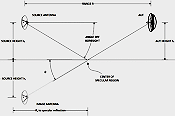 "Since the advent of compact antenna test
ranges and, somewhat more recently, near-field antenna test ranges, the number of
newly built indoor test facilities has far surpassed the number of outdoor test
facilities that have been constructed.
Outdoor far-field testing requires suitable real estate, is subject to interference
from external transmissions, and requires favorable weather conditions. However,
the measurement of very large or very low-frequency antennas sometimes precludes
a suitable indoor configuration. While the antenna measurement methodology for outdoor
far-field direct illumination ranges is well established, and there are several
references to estimates of specific uncertainty terms, there are no comprehensive
recommended practices for the estimation of measurement uncertainty. This is in
contrast to the existing recommended practices for near-field and compact antenna
range measurements. In this article, we identify key uncertainty terms for an outdoor
elevated far-field antenna range and present a procedural methodology for predicting
and evaluating the measure of uncertainty. The method for analyzing each term is
described in detail in accordance with, commonly referred to as the Guide to the
Expression of Uncertainty in Measurement (GUM)..." "Since the advent of compact antenna test
ranges and, somewhat more recently, near-field antenna test ranges, the number of
newly built indoor test facilities has far surpassed the number of outdoor test
facilities that have been constructed.
Outdoor far-field testing requires suitable real estate, is subject to interference
from external transmissions, and requires favorable weather conditions. However,
the measurement of very large or very low-frequency antennas sometimes precludes
a suitable indoor configuration. While the antenna measurement methodology for outdoor
far-field direct illumination ranges is well established, and there are several
references to estimates of specific uncertainty terms, there are no comprehensive
recommended practices for the estimation of measurement uncertainty. This is in
contrast to the existing recommended practices for near-field and compact antenna
range measurements. In this article, we identify key uncertainty terms for an outdoor
elevated far-field antenna range and present a procedural methodology for predicting
and evaluating the measure of uncertainty. The method for analyzing each term is
described in detail in accordance with, commonly referred to as the Guide to the
Expression of Uncertainty in Measurement (GUM)..."
 The American Radio Relay League (ARRL) is
having a sale on its books and other items - but you'd better hurry to get them
delivered in time for Christmas. Choose from the Radio Handbook or Antenna Handbook,
license study guides (with question pools), kits, apparel, coffee mugs, patches,
pins, and stickers, logbooks, regulation manuals, and many instructional books on
a wide variety of radio topics. Deadlines are closing in. For a limited time, a
free 2024 W1AW Calendar is
included with any order, providing a monthly look inside the ARRL's flagship station. The American Radio Relay League (ARRL) is
having a sale on its books and other items - but you'd better hurry to get them
delivered in time for Christmas. Choose from the Radio Handbook or Antenna Handbook,
license study guides (with question pools), kits, apparel, coffee mugs, patches,
pins, and stickers, logbooks, regulation manuals, and many instructional books on
a wide variety of radio topics. Deadlines are closing in. For a limited time, a
free 2024 W1AW Calendar is
included with any order, providing a monthly look inside the ARRL's flagship station.
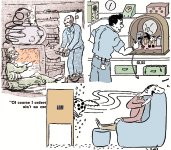 The December 1947 issue of Radio News
and the February 1954 issue of Radio & Television News published these
electronics-themed comics. Humor evolves over time, which is apparent when you
look over these and many of the other comics from these vintage electronics magazines.
The AVC comic is the best, IMHO. For those of you not around in the olden days of
vacuum tubes, tapping on a tube would often make it work properly again, either
because of a dirty contact in the socket or crud that had accumulated on the screen
grid. I give this batch a score of about 7 out of 10, but you might think otherwise.
There is a growing list of other comics at the bottom of the page. Enjoy... The December 1947 issue of Radio News
and the February 1954 issue of Radio & Television News published these
electronics-themed comics. Humor evolves over time, which is apparent when you
look over these and many of the other comics from these vintage electronics magazines.
The AVC comic is the best, IMHO. For those of you not around in the olden days of
vacuum tubes, tapping on a tube would often make it work properly again, either
because of a dirty contact in the socket or crud that had accumulated on the screen
grid. I give this batch a score of about 7 out of 10, but you might think otherwise.
There is a growing list of other comics at the bottom of the page. Enjoy...
 With more than 1000
custom-built stencils, this has got to be the most comprehensive set of
Visio Stencils
available for RF, analog, and digital system and schematic drawings! Every stencil
symbol has been built to fit proportionally on the included A-, B-, and C-size drawing
page templates (or use your own page if preferred). Components are provided for
system block diagrams, conceptual drawings, schematics, test equipment, racks (EIA
19", ETSI 21"), and more. Test equipment and racks are built at a 1:1 scale so that
measurements can be made directly using Visio built-in dimensioning objects. Page
templates are provided with a preset scale (changeable) for a good presentation
that can incorporate all provided symbols... With more than 1000
custom-built stencils, this has got to be the most comprehensive set of
Visio Stencils
available for RF, analog, and digital system and schematic drawings! Every stencil
symbol has been built to fit proportionally on the included A-, B-, and C-size drawing
page templates (or use your own page if preferred). Components are provided for
system block diagrams, conceptual drawings, schematics, test equipment, racks (EIA
19", ETSI 21"), and more. Test equipment and racks are built at a 1:1 scale so that
measurements can be made directly using Visio built-in dimensioning objects. Page
templates are provided with a preset scale (changeable) for a good presentation
that can incorporate all provided symbols...
These archive pages are provided in order to make it easier for you to find items
that you remember seeing on the RF Cafe homepage. Of course probably the easiest
way to find anything on the website is to use the "Search
RF Cafe" box at the top of every page.
About RF Cafe. I also
have an extensive list of
Recently Added topics.
Homepage Archive Pages
2024:
Jan |
Feb |
Mar |
Apr |
May |
Jun |
Jul |
Aug |
Sep |
Oct |
Nov |
Dec
2023:
Jan |
Feb |
Mar |
Apr |
May |
Jun |
Jul |
Aug |
Sep |
Oct |
Nov |
Dec
2022:
Jan |
Feb |
Mar |
Apr |
May |
Jun |
Jul |
Aug |
Sep |
Oct |
Nov |
Dec
2021:
Jan |
Feb |
Mar |
Apr |
May |
Jun |
Jul |
Aug |
Sep |
Oct |
Nov |
Dec
2020:
Jan |
Feb |
Mar |
Apr |
May |
Jun |
Jul |
Aug |
Sep |
Oct |
Nov |
Dec
2019:
Jan |
Feb |
Mar |
Apr |
May |
Jun |
Jul |
Aug |
Sep |
Oct |
Nov |
Dec
2018:
Jan |
Feb |
Mar |
Apr |
May |
Jun |
Jul |
Aug |
Sep |
Oct |
Nov |
Dec
2017:
Jan |
Feb |
Mar |
Apr |
May |
Jun |
Jul |
Aug |
Sep |
Oct |
Nov |
Dec
2016:
Jan |
Feb |
Mar |
Apr |
May |
Jun |
Jul |
Aug |
Sep |
Oct |
Nov |
Dec
2015:
Jan |
Feb |
Mar |
Apr |
May |
Jun |
Jul |
Aug |
Sep |
Oct |
Nov |
Dec
2014:
Jan |
Feb |
Mar |
Apr |
May |
Jun |
Jul |
Aug |
Sep |
Oct |
Nov |
Dec
2013:
Jan |
Feb |
Mar |
Apr |
May |
Jun |
Jul |
Aug |
Sep |
Oct |
Nov |
Dec
2012:
1 |
2 |
3 |
4 |
5 |
6 |
7 |
8 |
9 |
10 |
11 |
12 |
13 (no archives before 2012)
|

































 Empower RF Systems
Empower RF Systems













 Comics
Comics Werbel Microwave
Werbel Microwave




 Homodyne reception
Homodyne reception






